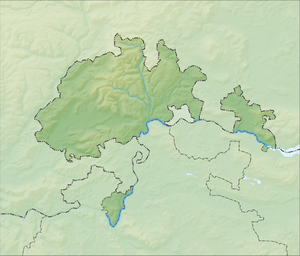Radegg ruins
| Radegg ruins | ||
|---|---|---|
| Creation time : | 13th Century | |
| Castle type : | Höhenburg, spur location | |
| Conservation status: | ruin | |
| Standing position : | Barons von Radegg (not secured) | |
| Geographical location | 47 ° 39 '6.1 " N , 8 ° 30' 23.8" E | |
| Height: | 560 m above sea level M. | |
|
|
||
The Radegg ruin is a spur castle built around 1200 and destroyed around 1300 in the canton of Schaffhausen , Switzerland . It lies at 560 m above sea level. M. high above the Wangental on a rock spur of the Rossberg , which drops steeply on three sides and belongs to the municipality of Wilchingen , district of Osterfingen.
history
The Radegg ruins were explored between 1923 and 1937. Despite this, little is known about its origins and destruction, or about its builder, the Lords of Radegg. Heinrich Scado was first mentioned in 1188. Around 1225 a knight "Rudolf nobilis dictus Schade de Radegg" is listed in a document. He is said to have maintained unspecified relationships with the Rheinau monastery . In the 13th century there was a second family with the same name in the area alongside the Barons von Radegg. The middle-class Schad von Radegg family settled in Schaffhausen in the late Middle Ages . This makes it difficult to reliably assign individuals to the Radegg ruins. The barons died out in 1333. According to Johann Jakob Rüeger , the Randeckers were related to the lords of the castles of Burg Randeck (Esslingen district) , Randenburg and Randegg Castle .
The remains of the wall that can still be seen today were not built before 1200. It cannot be ruled out whether there was a previous wooden building at this point, but it has not been proven either. The castle was probably destroyed shortly after 1300. By whom and why is unclear. Various limestones are reddened on the inside. This suggests a fire. One reason for the destruction could be that around 1270 the Radeggers tried to protect the Rheinau monastery from the claims of the bailiffs of the neighboring Lords of Krenkingen . Arrowheads and crossbow bolts have also been found during excavations .
investment
The castle was built in one go. It comprised (from east to west) a mighty tower, an intermediate building or courtyard with a cistern and a second tower. The eastern walls of the attack sides are up to four meters thick, but the south wall, which slopes steeply towards the Wangental, is only 2.80 meters. The construction concept with embossed corner blocks and mighty stone blocks suggest a construction time around 1200. The plateau to the northeast is protected by undated walls and ditches. In addition, traces of earlier material extraction are still visible.
tourism
Hiking trails lead from Osterfingen through the Wangental to the Bad Osterfingen restaurant and on to the Radeggerhalde. There follows a steep ascent directly to the ruin. The second path runs less steeply from Osterfingen through the haarel valley to the Rossberghof restaurant . From there it takes about 30 minutes to get to the ruins.
The facility is freely accessible with the necessary care. There is a rest area with a fireplace by the ruins.
The legend of the Kätterli
The Schaffhausen dialect poet Otto Uehlinger tells in his saga vom Kätterli about a robber baron who lived hundreds of years ago with his wife and seven sons at Radegg Castle. The pious woman died in childbed after the birth of the first girl. The girl was christened Kätterli. After the death of his kind wife, the knight lost all decency and chivalric disposition. He and his sons plundered and plundered the area. Even travelers who came through the Wangental were not spared. Many prisoners who braised in the castle dungeon were cared for and cheered up by the adolescent, kind-hearted Kätterli. An Italian nobleman fell in love with her. After paying a large ransom, he was released and asked for Kätterli's hand. But she did not want to leave her family or the prisoners. A year later, the aristocrat Kätterli had a blue-blooming rose bush brought. Kätterli planted the roses in the Radeggerhalde. Whenever she had grief and worries, she secretly visited the rose bush.
The robber barons did it more and more colorful. That is why the warlords of Schaffhausen and the farmers of Osterfingen decided to finally put an end to the hustle and bustle. On a cold winter night they crept to the castle and set it on fire. When the castle was already ablaze, the attackers noticed Kätterli calling for help at a window. Before they could rush to his aid, the roof structure collapsed overhead. The unfulfilled love does not let Kätterli rest to this day. You can still see it sitting on the ruins on a moonlit night. It prays for the souls of their families and waits for salvation. Only a young fellow without blame or blame who finds the blooming rose and brings it to Kätterli can redeem it.
literature
- Thomas Bitterli-Waldvogel: Swiss Castle Guide .
- Heinrich Boxler: Swiss contributions to the cultural history of the Middle Ages . No. 22, 1995, pp. 111-112.
- Werner Meyer (Red.): Castles of Switzerland. Volume 5: Cantons of Zurich and Schaffhausen .


